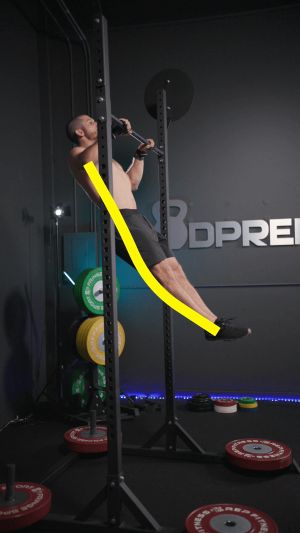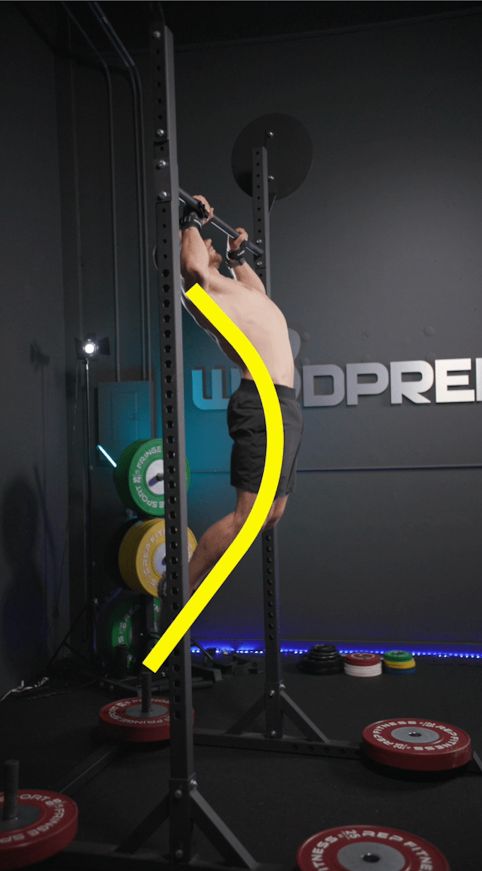Want to get competition-ready by perfecting the butterfly pull-up? You’re in the right place.
But before we get into all the technical details, remember that they are only for competition because, when done well, they help you to get the maximum reps in the shortest amount of time.
This article takes you through everything you need to know, from perfecting your grip and form to the subtle differences between normal butterfly pull-ups and chest to bar butterfly pull-ups.
Let’s get started.
Grip
When learning the butterfly pull-up, before focusing on what the rest of your body needs to be doing, it’s important to establish the basics, starting with grip.
When you jump up to the bar, the first thing to do is jump into a hollow body position and then grab the bar.
When I grab the bar for a butterfly pull-up, I like to bump my hands out a little bit wider. So whereas with a kipping pull-up, your hands will sit just outside the shoulders, with a butterfly pull-up, you’ll need to bump it out an extra inch or two on each side.
For a chest to bar butterfly pull up, you may find it’s a little more comfortable with your hands sitting even wider apart.
What that does is decrease the range of motion in your arms, so it gives you more space to get your chest into the bar. The narrower your hands, the harder it is to pull the bar all the way to your chest, but if your hands are wider, it’s easier for you to make contact with the bar.
Top tip: hand care
One of the downsides to practising the butterfly pull-up is that it increases the risk of ripping your hands – not good. Wearing grips will help keep your hands intact, but if you want to do a deep dive into hand care, check out my in-depth video guide.
Top tip: thumbs over or under?
As you jump up into that hollow body position, make sure you grip the bar properly. You need to aim to have your thumbs wraps around the bar.
If you want to avoid flying off your bar mid-pull-up, make sure you’re not doing the suicide grip, which is where your thumb sits over the bar. I know lots of CrossFit Games athletes do the thumb over the bar, but lots of top gymnasts and coaches in the world recommend wrapping your thumb around the bar to keep you secure.
Perfecting your butterfly pull-up
Once you’ve established that hollow body position, it’s time to get into your first arch. This is the best way to develop the tension that sets you up for the butterfly pull-up.
To get into your arch position, keep your feet together and extend them behind your body as you drive your head and shoulders through the bar and underneath the bar. Your head and shoulders should be in front of the bar while your hips and feet are behind the bar creating tension.
Because of that tension, you can then snap back into the butterfly pull-up. As you snap back, you then need to do what I call the scoop to hollow.
As your feet come underneath with extended legs, you then need to begin to lever your shoulders back. At the same time, your feet should move from behind your body, passing below you as you move into that hollow body position.
As you go through the hollow body position, you need to then lever and lift. So as your feet are scooping and lifting up, you’ll lever yourself back, closing the angle of your shoulders.
The idea is to get your head and shoulders away from where you started so you’re not trying to pull directly into the bar. Instead, you’re trying to get a little bit of space away from the bar to make room for the actual butterfly version of the pull-up. That will give you the room you need to fall back through into the butterfly kick.
Here, you’re allowing your feet to pull you up, and you’re lifting your body up with the momentum of the kick from your feet. As you can see, your feet need to keep going up as you maintain a hollow body position. As you close the angle, you’ll also get a bit of a hip-pop that accelerates you up.
As you do this, try to get your chin and chest up and away from the bar so that right at the apex, you’re away from the bar and doing one of two things: either passing your chin above the bar (for normal butterfly pull-ups) or barely skimming the bar with your chest (for the chest to bar version).
With both versions of the butterfly pull-up, I like to maintain a proud chest while keeping my head up.
A common problem I see is when people tuck their chin while they’re doing this movement. When you do this, it feels like you’re going to run into the bar, and it’s easy to end up smacking your teeth against the bar doing this – ouch.
Meanwhile, looking up with a proud chest will make space for that bar to pass around your head and for your chest to touch the bar.
You’ll notice here how far away my chin is from the bar when it reaches the apex. When it crosses that horizontal plane, I’m actually not above the bar; I’m quite a bit away from it. It’s the same thing with the chest to bar technique – my chin is away from the bar while my chest barely skims it as I start to work my way back down.
Your legs still need to be fully extended and up at this point in the movement. This is because the momentum from the scoop will help to lift your body into the butterfly pull-up. And that’s your first rep complete.
Once you’ve achieved that first rep with your chest touching the bar or your chin reaching the apex, only then do you start to pull yourself back under through the bar while pulling your feet behind your body.
A common mistake that I see people making is when they try to tuck their feet back too early before finishing the rep. To avoid this, you need to make sure you’re staying longer and finishing your scoop, lifting and levering yourself up to the apex of the movement before allowing yourself to pull through as the feet come back and you re-initiate the arch position.
After that, simply rinse and repeat.
So going in order, you’re scooping, you’re levering, you’re coming up, you’re getting to the apex of your rep, and then you’re pulling yourself back under. So rather than thinking of it as one rep at a time, think of it like a continuous circle of reps.
Butterfly pull-ups vs butterfly chest-to-bar
Other than the wider hand placement, there are some other slight differences that separate the butterfly pull-up from the butterfly chest to bar pull-up.
With the butterfly chest to bar pull-up, you need to let your legs scoop for a little bit longer, pull a little bit higher and leverage the body higher so that your chest touches the bar.
So compared with the traditional butterfly pull-up, you’ll need a few more inches of height, meaning the butterfly chest the bar requires more patience and pulling to make sure you get your body higher than the standard butterfly pull-up.
This can make things a little more awkward, but if you follow my tips to keep that proud chest, keep your head up and away and think about the lever, lift and scoop, you’ll be able to drive the momentum you need to lift your body higher.
Getting started
If you’re just starting to learn the butterfly chest to bar, I would suggest starting with single reps to see if you can get the consistent touching of the chests of the bar before stringing together a bunch of big unbroken sets. This will make sure your form is on point and that you’re reducing the risk of injury. Once you’ve perfected the single rep, you can then begin to pepper in unbroken sets.
If you want to learn more, check out my free step-by-step butterfly pull-up guide.
Alternatively, if you’re someone who really wants to take it seriously, I have a butterfly pull-up development course called butterfly pull up breakthrough. This is an 8-week course that will teach you how to do a proper butterfly pull-up with drills and programming that you can add to your normal training. Check out it today.



